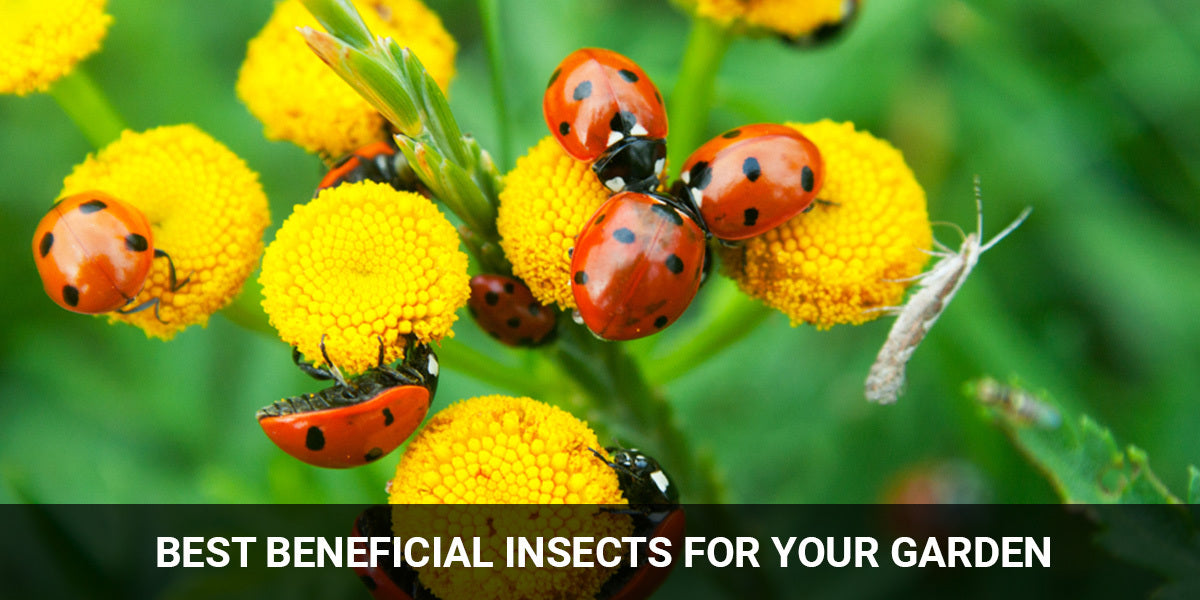How to Grow
From Pest Control to Pollination: The Top Beneficial Insects for Gardens
We have often heard that insects are harmful to plants.
But some of us are not aware of one such thing that not all insects found in the garden are harmful.
Yes, some of the insects are beneficial to plants and they actually help the plants in sustainable ways.
In this blog, you will know about major beneficial insects that are actually beneficial to plants and their importance in natural pest control.
What are beneficial insects?
Beneficial insects are insects that benefit the plants and ecosystem by performing different vital activities like pollination and natural control of pests. They are the effective service providers to keep the damage-causing pests in check naturally by feeding on them. So we can call them natural enemies of harmful pests.
Beneficial insects are categorized into 3 types based on their way of approach to natural pest control and pollination as the following
1. The Predators
Predatory insects prey and feed on other insects for food.
Eg - Ladybird beetle, ground beetles, lacewings, spiders, aphid midges, syrphid flies, yellow jacket wasps, etc
2. The Parasitoids
Adult parasitoids are free-living insects and adult female parasitoids lay eggs inside or on the host insects. Due to this action, immature parasitoids develop within or on the host insects and eventually kill them.
Eg - Parasitic wasps, tachinid flies
3. The Pollinators
Pollinators are the group of insects involved in pollination. They visit flowers to feed on nectar and carry pollen from the male part of the flowers (stamen) to the top portion of the female part of the flowers (stigma). Pollinators play a very crucial role in fruit and seed production in plants.
Eg - Honey bees, wild bees, butterflies, moths, and leafcutter bees
List of beneficial insects for plants
Many of us are aware of honey bees and butterflies as we often hear about them and see them in our garden. But many beneficial insects which rarely noticed by us are protecting our plants without our knowledge. Here is the introduction about major beneficial insects that are protecting plants from harmful pests.
1. Ladybird beetles/Ladybugs

You may have observed these dome-shaped and bright-colored beetles on plants in the garden. Ladybird beetles are the natural predators of most destructive pests such as aphids, whiteflies, scales, mites, mealybugs, thrips, and other soft-bodied insects.

Both larvae and adults of ladybird beetles prey on the serious pests of plants. Larvae (immature form of an insect) feed on soft-bodied pests but they don’t feed on pollen and nectar. The feeding habit of adult ladybird beetles is similar to larvae, in addition to that, they also feed on nectar and pollen. One more interesting fact about the larvae of ladybird beetles is, they can feed on 40 aphids in an hour.
2. Ground beetles

The size, shape, and color of ground beetles vary from species to species. Most of them are dark brown to metallic black in color with a flattened hard body. Both adults and larvae of ground beetles are the ferocious predators of caterpillars, thrips, weevils, nematodes, slugs, and grasshopper eggs. Some specialized groups of beetles with hook-shaped mouthparts also feed on snails. Most commonly ground beetles prefer to live under barks of trees, among rocks, or under some low-growing plants to protect themselves from their enemies.
3. Green Lacewings

Green lacewings are one of the excellent active predators that protect our plants from harmful insects throughout their growing season. Larvae of green lacewings are beneficial to biological pest management in a wide variety of plants. At their larval stages, green lacewings are voracious feeders of most soft-bodied insects like aphids, mites, small caterpillars, mealybugs, immature whiteflies, and even eggs of some species. Larval green lacewings are popularly known as “aphid lions” because of their voracious predatory nature on aphids.
4. Spiders

You might have noticed spiders among garden plants. But all of them are not beneficial to the plants. It is necessary to know how to distinguish between harmful and beneficial spiders.

It helps to eliminate harmful spiders and allows only beneficial predatory spiders to do their work. Among the spiders, only wolf spiders, sac spiders, orb-weaver spiders, and jumping spiders play an important role in controlling the populations of many harmful insects.

They feed on pests including aphids, wasps, beetles, mosquitoes, grasshoppers, and fruit flies throughout the growing season.
5. Syrphid flies/Hoverflies

Adult syrphid flies resemble honey bees in their looks. These yellow and black flies are often seen hovering above flowering plants and pest colonies, hence they are also known as hoverflies.

Adult syrphid flies are efficient pollinators and they lay their eggs near pest colonies. The emerged syrphid larvae are the natural enemies. Larvae feed on aphids, scales, thrips, and other soft-bodied insects. Syrphid fly larvae look similar to pest caterpillars. The only difference is syrphid fly larvae do not have any legs whereas pests caterpillars have legs.
6. Praying mantids

You have probably seen these eye-catching, triangular-headed insects in your garden before. Their bent and angled body posture make them look like they are praying, thus they are popularly known as praying mantids. Praying mantids are one of the most beneficial predatory insects and they feed on a wide range of pests like caterpillars, moths, beetles, gnats, and crickets. Sometimes female praying mantids feed on male praying mantids just after mating. This type of ecological interaction of consuming another individual of the same species is known as Cannibalism.
7. Minute pirate bug

Minute pirate bugs are one of the efficient predatory bugs that start hunting their prey early in the growing season. These oval-shaped, black and white bugs are most commonly seen during the warmest days of the autumn season. Both nymph (immature form of invertebrates, that resembles adult insects) and adults of minute pirate bugs feed on plant pests including aphids, spider mites, thrips, psyllids, whiteflies, caterpillars, and also on insect eggs.
8. Aphid midge

Aphid midges are one of the beneficial predatory insects. They are the most efficient and voracious feeders of 60 types of aphid species and their strategy towards aphid population check is more effective than green lacewings. An individual aphid midge larva can consume up to 65 aphids in a day. Adult female aphid midges usually lay their eggs among the aphid colony so that hatched larvae can get immediate food. Larvae of aphid midges paralyze the legs of aphids by injecting poison into the joints and then they consume them.
9. Predatory mites

Predatory mites are the best service providers you need for the natural control of spider mites. These pear-shaped tiny mites are similar to their prey spider mites in looks. But the only difference is predatory mites have long legs when compared to spider mites, this even helps them move faster than their prey. Adult predatory mites feed on spider mites, thrips, gnat larvae, and other pest mites. When there is no pest infestation, predatory mites feed on pollen and nectar without harming the plants.
10. Tachinid flies

Tachinid flies are one of the world’s largest groups of parasitoidal beneficial insects. Although they are tiny in size, their service in keeping the pests in check is overwhelming. Tachinid flies somewhat resemble house flies in their looks but you can identify them by their spiny bristles. Most of the tachinid flies are internal parasites. Adult female tachinid flies can insert the eggs inside by piercing the host body and some lay eggs among the pest colonies. After the eggs hatch, maggots of tachinid flies get ingested into the body of the host while consumed by them and then maggots start to develop inside the host body. Eventually, they kill the host. They attack and feed on pests including caterpillars, grasshoppers, sawfly larvae, cutworms, adult and larval beetles.
11. Parasitic wasps

We rarely notice the activity of parasitic wasps because of their tiny body. But their importance in biological pest control is immense. They are one of the beneficial insects that offer their efficient service in keeping the pests population in check including aphids, caterpillars, whiteflies, and dotted cucumber beetles.

Parasitic wasps lack an ovipositor, hence they can’t insert eggs inside the host body. Instead of that, they lay their eggs on plants that are eaten by their prey. Eaten eggs hatch inside the pest's body and eventually result in the death of the pest.
12. Honey bees

There is no one who has not heard the name of the honey bees. Honey bees are the most popular hardworking beneficial insects in our ecosystem. They are beneficial to humans and plants in many ways. We all are well aware of their service in economically important honey and other hives by-products production. Apart from this, honeybees are the most important part of crop production. They play a very significant role in pollination. When honey bees visit the flowers to collect nectar and pollen, some pollens from the male reproductive part, stamen, stick to their hairy body and they transfer the carried pollen to the stigma, top of the female part of the same flower or different flower. This service of honey bees aids the reproductive success of plants.
Importance of Beneficial insects in pest control
- Beneficial insects are efficient service providers in natural pest control. Here there is no interference of humans needed and this process will carry out by naturally existing beneficial insects. Beneficial insects feed on prey and help in keeping the pest population in check. This helps to reduce the loss of agricultural output in a significant way and also helps in increasing global crop production.
- Beneficial insects play a significant role in biological pest control. Here man uses the basic strategy of natural pest control by introducing and manipulating the predators and parasitoids purposefully to the agroecosystem to reduce the pest population.
- Beneficial insects offer us the chance to reduce the usage of chemical pest control measures and thus they help in building a sustainable ecosystem.
- Several destructive pests have developed resistance towards chemical pesticides, thus their population is not reducing even after using pesticides. But they can’t escape from the predators and parasitoids.
How to attract beneficial insects to the garden?
- Broad-spectrum insecticides can kill a wide range of insects including beneficial insects. In order to protect their population in your garden, reduce the use of broad-spectrum insecticides and use less toxic organic pest controllers.
- If you are using any insecticides, then consider spot spray only on infested plants, not on healthy ones.
- Spray neem oil or any other organic pest controllers early in the morning or in the late evening, when the insect's activity is low.
- Flowering plants attract beneficial insects to the gardens. Plant early blooming plants so that beneficial insects can start to visit your garden in the early growing season before any pest attack.
- Grow short-statured, shrub-like plants and tall statured plants in the garden. Beetles prefer shrubs or any short-statured plants to hide. Some insects like wasps, honey bees, butterflies, and others like to feed on nectar, so tall flowering plants offer them food.
- Mulching the ground provide the preferable habitat to ground beetles.
- Create a simple water source in the garden. This helps you to keep beneficial insects hydrated.
FAQs Related to Plant Friendly Insects
1. What are biological control agents?
Biological control agents are the living organisms that are used to control the population of insect pests. Biological control agents include beneficial insects and microbial control agents such as Bt, viruses, and nematodes.
2. What is the difference between plant pests and beneficial insects for plants?
Plant pests are insects that are harmful to plants in many ways. Whereas beneficial insects are helpful in keeping the harmful pests in check and also helpful in pollination.
3. What is the meaning of pollination?
Pollination is the process of transferring pollen from the male reproductive part of a flower (stamen) to the top of the female reproductive part of the same flower (stigma) or a different flower to aid the reproduction of plants.
4. What is the meaning of host?
The host is an organism that is attacked by predators or parasitoidal organisms for food and shelter.
5. What is the meaning of prey?
The prey is an organism that is being hunted and killed by another organism for food.
6. Are earwigs beneficial?
Yes, earwigs are beneficial insects. They help the ecosystem by feeding on decaying plant residues and dead insects like aphids, mites, and nematodes.
7. What are broad-spectrum insecticides?
Broad-spectrum insecticides are synthetic insecticides that are specifically designed to control or kill a wide variety of insects when the specific insect that causes harm is unknown.
8. How do I attract ladybugs to my vegetable garden?
Ladybugs prefer to feed on the nectar of the flowers. So consider growing brightly colored flowering plants like marigold, cosmos, and calendulas to attract them to your garden.
9. What is Entomophily?
Entomophily is nothing but insect pollination, which is a form of pollination where the insects are helpful in the distribution of pollen of plants.
10. Why biological pest control is important?
Biological pest control is a potential measure to reduce the pest population in the agroecosystem when compared to chemical pest control. It is very efficient and does not harm the environment like chemical pesticides.
Popular Searches: Garden Accessories for Sale, Compost Bin India, Plastic Flower Pots Online, Contemporary Plant Pots, Hanging Pots Online, Colorful Plant Pots, Bird Feeders Online, Rectangular Planters Online, Small Pots Online, Flower Pots Online, Kitchen Waste Compost Bin, Balcony Railing Planter, Buy Pots Online, Indoor Plant Pots, Metal Flower Pot



